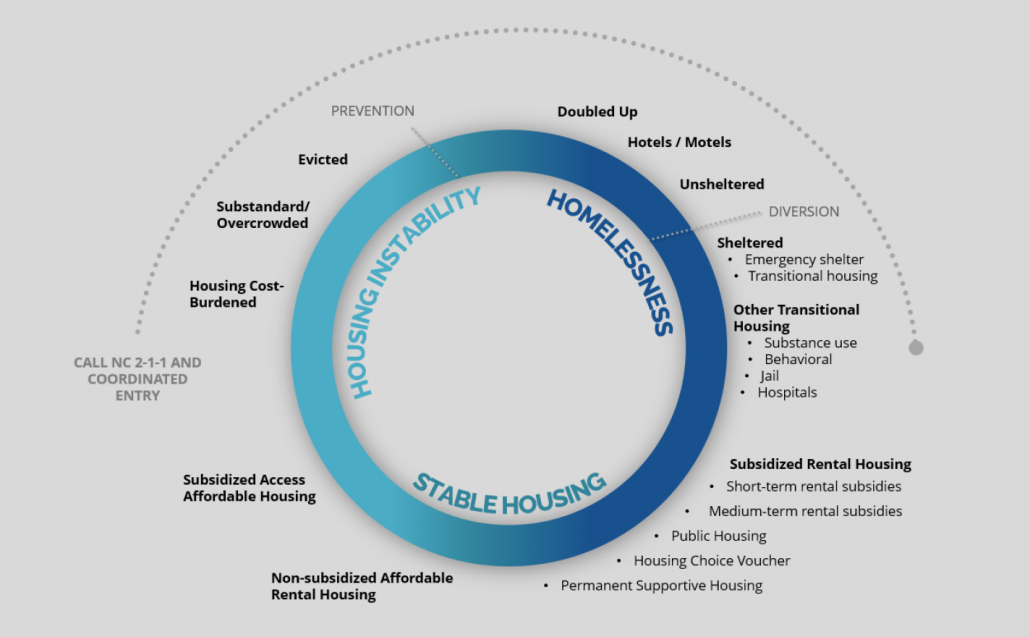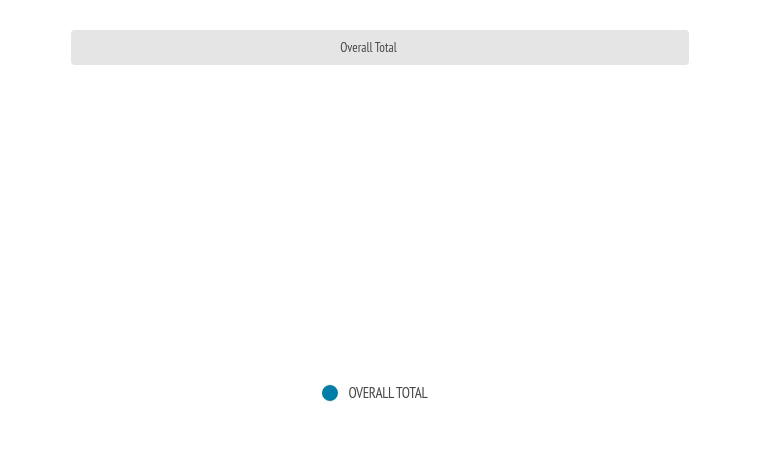Courtney LaCaria
Housing & Homelessness Research Coordinator
Mecklenburg County Community Support Services
In August, the Building Bridges Blog launched a new, monthly data update. This effort, called the Housing & Homelessness Continuum Data Update, is intended to move the community from a focus on the One Number to a more comprehensive data set.
This new update will attempt to cover the full housing continuum, from housing instability to homelessness. Even with the progress made to enumerate homelessness using the One Number (which includes sheltered and a portion of unsheltered homelessness), there are still many households who experience housing instability and homelessness and who are not yet captured. It is critical to identify the households “in the gap” to both understand the need for services and to construct effective solutions to address these needs.
This approach is also an important outcome of the Charlotte-Mecklenburg Housing & Homelessness Strategy (CMHHS): identifying and closing the remaining gaps in data collection and reporting across the full housing continuum. To that end, this week’s blog will use the new data to provide an update on the current state from a demand-side viewpoint: the number and characteristics of people experiencing housing instability and homelessness. This blog will also highlight the data gaps that exist and the work underway to address those gaps.
Housing & Homelessness Continuum: the Latest Data
The graphic depicted below helps visualize the interrelationship of all components comprising the full housing continuum. In addition, definitions are provided for housing instability and homelessness. Finally, a table is provided with the latest system-level metrics, as well as gaps, for both housing continuum components.
Housing Instability
Housing Instability is a type of housing status that exists along the housing instability and homelessness continuum. Housing instability can occur when an individual or household experiences any of the following: living in overcrowded and/or substandard housing; difficulty paying rent or mortgage; experiencing frequent moves due to economic or affordability reasons; doubling up with family or friends; or living in hotels. Cost-burden is frequently used as a measure of housing instability. Many people who become homeless have faced housing instability.
Housing Instability Data
This data will be updated after the October 2021 release of the 2021 Charlotte-Mecklenburg State of Housing Instability & Homelessness report.
Homelessness
Homelessness is a type of housing status that exists along the housing instability & homelessness continuum. Homelessness, by definition, means the loss of housing. Homelessness can occur when a household lacks a fixed, regular, and adequate nighttime residence. This can include doubling up with family and/or friends; paying to stay week to week in hotels/motels; temporarily residing in a shelter and/or transitional housing facility; experiencing unsheltered homelessness; exiting an institutional setting within a set period of time after previously experiencing homelessness; and/or fleeing domestic violence. The definition of homelessness employed varies by funding source.
Homelessness Data
The chart below provides the latest data on homelessness using available system-level approximations.
Homelessness Trends
The chart below provides the historical change in One Number totals including the total number of people experiencing homelessness, single individuals, families, unaccompanied youth, Veterans, and people experiencing chronic homelessness.
To read more about the latest trends and analysis as well as access disaggregated One Number data by race and ethnicity and by age, click here.
SO, WHAT
Enumerating the number of people who need housing assistance across the entire housing continuum is complicated. There are some system-focused data collection tools, like the Housing Management and Information System (HMIS), which include multiple housing and homeless providers; however, overall housing continuum input data is fragmented. The reasons for this fragmentation are as varied as the fragments, themselves.
For example, there are many different definitions of homelessness; these definitions vary by the funding source or oversight body intended to address the problem. This inherently means that the reporting of data across the housing continuum is similarly segmented. Different programs serve different populations, who in turn fall in different places along the homelessness continuum. But having different definitions is not the entire issue; nor does simply aligning definitions fix everything.
In fact, the definition of homelessness used by CMHHS is intentionally broad, and inclusive of existing definitions. But without a standardized intake assessment and data collection process for everyone on the full housing continuum, and without a single mechanism to aggregate and de-duplicate the data collected, it is difficult (if not impossible) to look at all housing and homelessness data at a systems level. For that reason, missing data and gaps will continue to be highlighted until they are closed.
It is essential that communities, like Charlotte-Mecklenburg, have the fullest possible picture to quantify need; estimate cost; secure funding; implement solutions; and evaluate results. On September 20, 2021, the United States Interagency Council on Homelessness (USICH) and the U.S. Department of Housing & Urban Development (HUD) launched: House America: An All-Hands-On-Deck Effort to Address the Nation’s Homelessness Crisis, which is a system-focused framework. Through House America, local and state leaders are invited to participate in a national partnership that maximizes the American Rescue Plan (ARP) funding to address homelessness, utilizing a Housing First approach, to add new units of affordable housing (even if under development) by December 31, 2022. Federal funding includes 70,000 emergency housing vouchers; $5 billion in HOME grants; and $350 billion in State and Local Fiscal Recovery Funds through the Department of the treasury.
Charlotte-Mecklenburg can use this newly released resource so that ARP funding can have a shot at changing the trajectory of housing instability and homelessness in the community. Knowing who is actually in need, and where those individuals and families are situated along the housing instability and homelessness continuum, is absolutely critical to maximizing this, and all other resources.
SIGN UP FOR BUILDING BRIDGES BLOG
Courtney LaCaria coordinates posts on the Building Bridges Blog. Courtney is the Housing & Homelessness Research Coordinator for Mecklenburg County Community Support Services. Courtney’s job is to connect data on housing instability, homelessness and affordable housing with stakeholders in the community so that they can use it to drive policy-making, funding allocation and programmatic change.




